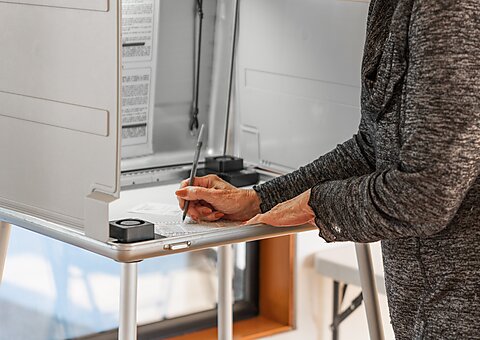
In testimony before a House committee, a Republican witness recently cited as credible claims by researcher James Agresti that “10% to 27% of non‐citizens are illegally registered to vote” and predicted that “about 5% to 13% of them will illegally vote in the 2024 presidential and congressional elections.” Speaking to New York Times reporter Minho Kim for an article published today, I stated,“These numbers simply aren’t believable… They aren’t consistent with what we know from the various other sources.”
For those who are coming in late, these startling estimates of the rate of illegal noncitizen voting can be traced to a 2020 paper by Agresti that in turn depended on a 2014 article by Jesse Richman et al., based on responses to the Cooperative Congressional Election Study (CCES) for the 2008 election. The Richman et al. paper came under intense critical scrutiny from, among others, Harvard’s Stephen Ansolabehere et al, writing under the auspices of the CCES itself, of which Ansolabehere is principal investigator (“Perils of Cherry Picking Low Frequency Events in Large Sample Surveys”) They wrote:
The advent of large sample surveys, such as the Cooperative Congressional Election Study (CCES), has opened the possibility of measuring very low frequency events, characteristics, and behaviors in the population. This is certainly a worthy objective, but researchers must use caution when studying low probability events and behaviors, such as non‐citizenship rates and voting. Even very low‐level measurement error can lead to classification and prediction errors and incorrect inferences in analyses.
This paper documents how low‐level measurement error for survey questions generally agreed to be highly reliable can lead to large prediction errors in large sample surveys, such as the CCES. The example for this analysis is Richman, Chattha, and Earnest (2014), which presents a biased estimate of the rate at which non‐citizens voted in recent elections. The results, we show, are completely accounted for by very low frequency measurement error; further, the likely percent of non‐citizen voters in recent US elections is 0.
Zero, of course, functions here as a rounding number and not as an assertion that literally no noncitizens voted in 2008. It signifies simply that alternative rounding numbers, such as 5 or 3 or 1 percent, would likely be less accurate. (Maggie Koerth, writing at Five Thirty‐Eight, describes the origins of the Richman et al paper, which didn’t begin as an effort to measure illegal voting at all; its authors appear to have been chagrined at the way it was pressed into service to fuel fraud narratives.)
More recently, Glenn Kessler of the Washington Post established through public records requests that in recent Arizona litigation in which Richman was granted access to state data, his resulting report embraced a drastically reduced estimate of noncitizen voting prevalence, most likely below a one percent noncitizen registration rate and half that for voting. (Agresti, seeking to rebut Kessler’s account, says Richman told him that as expert testimony his estimates in the Arizona case were couched to be robust to cross‐examination.) Critics suggest those numbers are still too high, but at least we are now in the same ballpark, namely a range between one percent and zero.
So is the percentage of noncitizens who vote, or register to vote, nearer to one percent or to zero? I’ve already summarized some of the reasons to think zero is the closer of the two, including database checks, surveys of election administrators, statistical tests (do voting totals track the citizen‐only voting‐age population, or do they come in unaccountably higher?), the scanty harvest of investigations and prosecution, audits in various states, and so forth.
Much more might be added along the same lines. In Ohio, the secretary of state announced in 2017 that a total of 821 non‐citizens were found to have registered in the state over the previous five years, 126 of whom actually voted. That’s among an electorate of roughly 8 million. (Seven years later, a new probe has found another 137 registrations.) The recent Republican House witness cited numbers from suburban DC’s immigrant‐heavy Fairfax County, Virginia, in which, he said, 278 noncitizen registrants had been identified of whom 117 had actually voted.
For purposes of comparison, the county had an estimated 342,000 immigrant residents around that time (not all of whom were of voting age, of course.) Numbers from jury selection—courts, of course, regularly use voter registration rolls as a basis to issue summonses for jury service, and when you show up for that duty you will be asked whether you’re a citizen—yield numbers not generally inconsistent.
Ironically, noncitizens in America show very little propensity to register or vote even in the handful of progressive jurisdictions that have given them the franchise in races for local offices, such as city council and school board. In the 2019 San Francisco school board race a grand total of two noncitizens are reported to have participated, and the numbers aren’t that much higher among municipalities in Vermont and Maryland (62 voters in Burlington, Vermont; 72 in Takoma Park, Maryland). If any sampling of noncitizens should be favorably disposed toward use of the ballot box it should be that in Washington, DC, which abounds in educated persons born overseas who have lived in the US for many years—think World Bank economists. But Kim reports that of the roughly 15 percent of DC’s 700,000 residents who are foreign‐born, only around 500 noncitizens had registered to vote as of Monday, according to data provided by the District of Columbia Board of Elections.
One might almost conclude that the progressive push for noncitizen local suffrage is more about the symbolic gesture than anything else. Against that symbolic gesture must be weighed the very real costs of worsening current social divisions and providing a giant opening for the alarmist theorizing already rampant on these topics.



